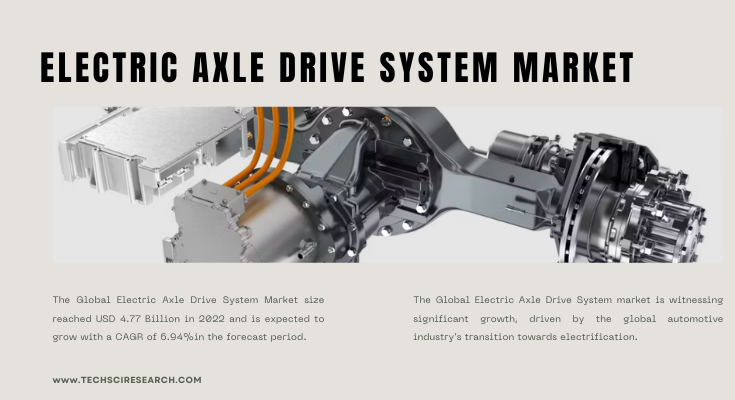According to TechSci Research report, “Electric Axle Drive System Market – Global Industry Size, Share, Trends, Competition Forecast & Opportunities, 2028”, the Global Electric Axle Drive System Market stood at USD 4.77 Billion in 2022 and is anticipated to grow with a CAGR of 6.94% in the forecast period, 2024-2028. The Global Electric Axle Drive System market is undergoing a transformative phase, aligning with the automotive industry’s profound shift towards electrification.
This shift is driven by environmental imperatives, stringent emissions regulations, and the rising consumer preference for electric vehicles (EVs). The Electric Axle Drive System serves as a pivotal component in the electric and hybrid vehicle landscape, offering a compact and integrated solution that combines electric motors, power electronics, and transmission into a single unit.
One of the key drivers behind the market’s growth is the increasing global adoption of electric vehicles. Governments worldwide are pushing for greener transportation solutions, and automakers are responding by integrating Electric Axle Drive Systems into their EV portfolios to meet stringent emission standards. The systems contribute to the efficiency and performance of electric vehicles, offering advantages in terms of energy consumption, reduced emissions, and overall driving experience.
Government incentives and supportive policies play a crucial role in propelling the Electric Axle Drive System market forward. Many countries offer financial incentives, tax credits, and rebates to both consumers and manufacturers to encourage the adoption of electric vehicles, creating a conducive environment for the integration of advanced electric propulsion systems. These incentives reduce the overall cost of electric vehicles, making them more attractive to consumers and encouraging automakers to invest in the development and deployment of Electric Axle Drive Systems.
Collaborations and partnerships within the automotive industry are fostering innovation in the Electric Axle Drive System market. Automotive manufacturers are teaming up with technology providers and suppliers to leverage expertise, share resources, and accelerate the development of electric vehicle technologies. This collaborative approach enhances research and development efforts, streamlines production processes, and addresses challenges related to cost reduction and standardization.
However, the market faces challenges such as the high initial cost of electric vehicles, limited charging infrastructure, and battery technology limitations. Despite these challenges, the Electric Axle Drive System market is dynamic and continuously evolving.
Ongoing advancements in technology, a growing focus on lightweight design, and innovations in thermal management and power electronics are shaping the market’s trajectory. The industry’s commitment to modular and scalable solutions, coupled with the rise of in-wheel motor technology and the exploration of two-speed electric axle drives, reflects a landscape marked by continuous innovation and adaptation to meet the demands of an electrified future. As the automotive industry undergoes a paradigm shift, the Electric Axle Drive System market remains a critical enabler in driving sustainable, efficient, and intelligent electric mobility solutions. For the latest and most accurate insights, it is recommended to refer to the latest industry reports and market analyses.
Browse over market data Figures spread through 180 Pages and an in-depth TOC on “ Global Electric Axle Drive System Market.” @ https://www.techsciresearch.com/sample-report.aspx?cid=20664
North America is a significant player in the Global Electric Axle Drive System market, driven by a combination of technological innovation, environmental regulations, and consumer demand for electric vehicles (EVs). The region, including the United States and Canada, has witnessed substantial growth in the adoption of electric axle drive systems as automakers accelerate the production of EVs to meet stringent emission standards. Government incentives, along with a robust charging infrastructure, contribute to the market’s expansion. Collaborations between traditional automakers and technology companies in North America further fuel innovation, positioning the region at the forefront of electric mobility trends.
Europe stands as a key market for Electric Axle Drive Systems, characterized by a strong commitment to sustainability, stringent emissions regulations, and a rapid transition towards electric mobility. Countries within the European Union are experiencing a surge in the adoption of electric vehicles, leading to a growing demand for efficient electric axle drive systems. The region’s focus on reducing carbon footprints aligns with the market’s trajectory, and collaborations among European automakers, suppliers, and research institutions contribute to technological advancements. A dense charging infrastructure and supportive government policies further solidify Europe’s role as a prominent market for electric axle drive systems.
The Asia-Pacific region, particularly China, Japan, and South Korea, is a dynamic and influential force in the Global Electric Axle Drive System market. China, in particular, leads the world in electric vehicle adoption, and the demand for electric axle drive systems is rising correspondingly. The region benefits from a combination of government initiatives promoting electric mobility, a rapidly expanding middle class, and a robust manufacturing ecosystem. Strategic investments by both domestic and international companies contribute to technological advancements and the development of cost-effective electric axle drive solutions. Asia-Pacific is poised to remain a key growth engine for the global market.
Latin America is gradually entering the Electric Axle Drive System market, driven by a growing awareness of environmental issues and a shift towards sustainable transportation solutions. While the adoption of electric vehicles in the region may not be as widespread as in other parts of the world, there is a noticeable interest in electric axle drive systems, especially in urban areas. Government incentives and collaborations between global automakers and local players contribute to the market’s development. The potential for growth exists as consumer awareness increases, and regulatory frameworks become more supportive.
The Middle East and Africa are exploring opportunities in the Electric Axle Drive System market, with a focus on addressing environmental challenges and embracing electric mobility. The region, characterized by varying economic conditions and infrastructure development, is witnessing a gradual shift towards sustainable transportation solutions. Government initiatives and investments in charging infrastructure contribute to the market’s development. While challenges exist, including the need for tailored solutions to suit local conditions, the Middle East and Africa represent emerging markets with the potential for significant growth in the electric axle drive system segment.
Major companies operating in the Global Electric Axle Drive System Market are:
- ZF Friedrichshafen AG (ZF)
- Dana Ltd.
- HELLA
- Toyota Industries
- Meritor Inc.
- Manga Iinternational Inc.
- Continental AG
- Ziehl Abegg SE
- Robert Bosch GmbH
- American Axle & Manufacturing Holdings
Download Free Sample Report @ https://www.techsciresearch.com/sample-report.aspx?cid=20664
Customers can also request 10% free customization in this report.
“In the electric mobility landscape, the rapid evolution of Electric Axle Drive Systems signifies a pivotal shift towards more efficient and sustainable transportation. Emphasizing seamless integration, modular design, and advancements in power electronics, experts foresee these systems playing a central role in shaping the future of electric vehicles, offering a compelling solution to enhance overall performance and drive the global automotive industry toward a cleaner and technologically advanced era.,” said Mr. Karan Chichi, Research Director with TechSci Research, a research-based management consulting firm.
“Electric Axle Drive System Market – Global Industry Size, Share, Trends Opportunity, and Forecast, Segmented By System Type (Electric System and Hybrid Electric System), By Vehicle Type (Passenger Cars and Commercial Vehicles), By Demand Category (OEM, Aftermarket), By Region, Competition, 2018-2028”, has evaluated the future growth potential of Global Electric Axle Drive System Market and provides statistics & information on market size, structure, and future market growth. The report intends to provide cutting-edge market intelligence and help decision makers take sound investment decisions. Besides, the report also identifies and analyzes the emerging trends along with essential drivers, challenges, and opportunities in the Global Electric Axle Drive System Market.
You may also read:
Automotive Brake Caliper Market on the Rise [2028]- A Deep Dive into the Growth & Forecast
Automotive Leaf Spring Market Insights- Strategies for Success in a Competitive Landscape [2028]
Alternative Fuel Vehicle Market Report- Understanding Market Size, Share, and Growth Factors [2028]
Automotive Collision Repair Market Trends- Navigating the Path to Sustainable and Effective Solutions
LED Fog Lamp Market Insights- Strategies for Success in a Competitive Landscape
Table of Content-Electric Axle Drive System Market
- Introduction
1.1. Product Overview
1.2. Key Highlights of the Report
1.3. Market Coverage
1.4. Market Segments Covered
1.5. Research Tenure Considered
- Research Methodology
2.1. Objective of the Study
2.2. Baseline Methodology
2.3. Key Industry Partners
2.4. Major Association and Secondary Sources
2.5. Forecasting Methodology
2.6. Data Triangulation & Validation
2.7. Assumptions and Limitations
- Executive Summary
3.1. Market Overview
3.2. Market Forecast
3.3. Key Regions
3.4. Key Segments
- Impact of COVID-19 on Global Electric Axle Drive System Market
- Global Electric Axle Drive System Market Outlook
5.1. Market Size & Forecast
5.1.1. By Value
5.2. Market Share & Forecast
5.2.1. By System Type Market Share Analysis (Bike Commuting, Car Sharing, Ride Sharing)
5.2.2. By Vehicle Type Market Share Analysis (Passenger Cars and Commercial Vehicles)
5.2.3. By Demand Category Market Share Analysis (OEM, Aftermarket)
5.2.4. By Region Market Share Analysis
5.2.4.1. Asia-Pacific Market Share Analysis
5.2.4.2. Europe & CIS Market Share Analysis
5.2.4.3. North America Market Share Analysis
5.2.4.4. South America Market Share Analysis
5.2.4.5. Middle East & Africa Market Share Analysis
5.2.5. By Company Market Share Analysis (Top 5 Companies, Others – By Value, 2022)
5.3. Global Electric Axle Drive System Market Mapping & Opportunity Assessment
5.3.1. By System Type Market Mapping & Opportunity Assessment
5.3.2. By Vehicle Type Market Mapping & Opportunity Assessment
5.3.3. By Demand Category Market Mapping & Opportunity Assessment
5.3.4. By Regional Market Mapping & Opportunity Assessment
- Asia-Pacific Electric Axle Drive System Market Outlook
6.1. Market Size & Forecast
6.1.1. By Value
6.2. Market Share & Forecast
6.2.1. By System Type Market Share Analysis
6.2.2. By Vehicle Type Market Share Analysis
6.2.3. By Demand Category Market Share Analysis
6.2.4. By Country Market Share Analysis
6.2.4.1. China Market Share Analysis
6.2.4.2. India Market Share Analysis
6.2.4.3. Japan Market Share Analysis
6.2.4.4. Indonesia Market Share Analysis
6.2.4.5. Thailand Market Share Analysis
6.2.4.6. South Korea Market Share Analysis
6.2.4.7. Australia Market Share Analysis
6.2.4.8. Rest of Asia-Pacific Market Share Analysis
6.3. Asia-Pacific: Country Analysis
6.3.1. China Electric Axle Drive System Market Outlook
6.3.1.1. Market Size & Forecast
6.3.1.1.1. By Value
6.3.1.2. Market Share & Forecast
6.3.1.2.1. By System Type Market Share Analysis
6.3.1.2.2. By Vehicle Type Market Share Analysis
6.3.1.2.3. By Demand Category Market Share Analysis
6.3.2. India Electric Axle Drive System Market Outlook
6.3.2.1. Market Size & Forecast
6.3.2.1.1. By Value
6.3.2.2. Market Share & Forecast
6.3.2.2.1. By System Type Market Share Analysis
6.3.2.2.2. By Vehicle Type Market Share Analysis
6.3.2.2.3. By Demand Category Market Share Analysis




